With the support of funding from the Erasmus + project, 21 workers from the Jarše Youth Home decided to take a study visit to Iceland – The Land of Fire and Ice.
The aim was to educate the employees through visits to governmental and non-governmental organizations in Reykjavík in the field of working with young people from vulnerable groups. We visited various organizations, had tours and presentations of programs and services, and exchanged professional opinions and experiences (examples of good practices) with the hosts. 100% attendance at the institution tours and completion of the final evaluation were mandatory. Active participation was expected from the participants during the entire study visit. Of course we also found time to enjoy and see some of great natural sights too.
DATE: 29 October – 3 November 2023
Day 1
- UMBOĐSMAĐUR BARNA – THE OFFICE OF THE OMBUDSMAN FOR CHILDREN
Time of visit: 10:00 – 12:00
host Eðvald Einar Stefánsson
The role of Ombudsman for Children is to guard and promote the interests, rights and needs of all children in Iceland under the age of 18. To improve the situation of children and ensure that consideration is given to their rights in all aspects of society. The Ombudsman doesn’t have the power to formally resolve cases, they only provide further information if needed. In the office, there are 6 employers with different educational background (3 lawyers, 2 pedagogics and 1 philosopher). The Ombudsman of Children has a five-year mandate, and can be re-elected one time. The office of Ombudsman for Children was established in 1994.

The projects/programs they are offering:
- Individual rights protection for children (pilot project): People call in the office of Ombudsman, and ask for help, their job is to inform about the rights, but not be part of the law case. The role of Ombudsman is to inform people about their rights or possible ways to resolve the problem.
- Collecting the date of approximate “waiting line” for different treatment for children: To find out what area need more founding or where do they need to improve. When they have results they publish the notes, discuss the problems with society and present the information to the government.
- The Young Advisory Group: For children between 12 – 17 years old. The meeting takes place once a month during school year. The group takes a small part of children parliament. They represent the office of the Ombudsman in external projects.
- The Children’s Forum 2023: Forum takes place every two years. Around 150 children between 11 – 15 years old, who are randomly selected from National Registry. Children join the forum and they take part of the round table discussion (20 tables). They are put into groups of 5 – 6 children, plus moderator and they have day discussions on different topics. This year topics are: participation, environment, education and health. At the end of each day a representative from parliaments and municipality join the group. At the end of Children’s Forum, the results are presented to the government and they publish a publication about their findings. They stressed out that this is one of their biggest projects, and they are very proud of it.
- The sustainable developing goals for Children council: 12 children, aged from 13 – 18. They are working to prevent sustainable development goal.
Discussion/questions:
- What is general opinion from society on the Ombudsman for Children?
People know how important it is for children voice to be heard. At first the opinion wasn’t noticeable, or wasn’t good, but it has grown over the years.
- What are the most common violations of children rights?
The children with disabilities often don’t have enough support, or the appropriate right of education, especially after elementary school. Children with behavioural problems are obligated to go to school till 16 years old, but because they have behavioural problems, many school programs don’t want to take them.
- How did Covid-19 affected children’s mental health?
Iceland is dealing with serious issues; children’s / youngster’s social and school life was affected. We are noticing that especially boys are more isolated and spend more time on computer. There is also an increase on ADHD diagnoses.
At the end of the presentation, we also asked about the current women’s protest for their rights. On October 24th Icelandic woman protested against gender pay gaps. This protest is traditionally held every year as a reminder to society that gender disparities are still relevant and that changes are needed in this area. Usually, the protest takes place only in the afternoon of that day, but this year, the organization arrange a more extensive, full-day protest, which was attended by more than 100000 women.
- TORPIĐ – YOUTH CENTER IN TOWN AKRANES
Time of visit: 13:30 – 16:00
host Ivar Orri Kristjánsson
https://www.facebook.com/hvitahus/ https://www.torpid.is/
Torpiđ is a youth center that promote leisure way of spending children’s free time. They are promoting new ways for young people to meet and help them develop leisure skills to have a healthier lifestyle. The name “Torpiđ” means village, and the meaning behind the name is that you need a village to raise a family. They are open 5 days a week, from 8:30 to 16:00, and after that they have afternoon activities that are free. They have 35 employees. They first opened in 1980 and were focused on children aged between 13 in 15, mainly for children who were on the streets and often had problems with alcohol. From 2020, they are expanding programs more towards younger children (from 3rd grade on). Their main focus is that all children can be a part of the community. They are financed from local authority. All the programs that starts after 16:00 are free of charge.
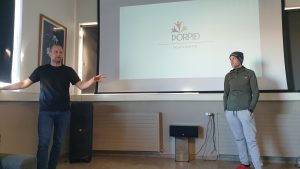
Program / projects they are offering:
- Kids valley (8 – 9 years old): after-school day care. Around 78 children.
- Day program (10 – 18 years old): afterschool program for children that are in need for special support (special needs children). Around 15 children.
- Leisure program/afterschool program (10 – 12 years old). A program that encourage a creative way of spending a free afternoon. Around 80 children.
- Arnardualur (13 – 15 years old): Their biggest program, 183 children. They are meeting 1 – 3 times a week from 7 pm – 10 pm.
- Huita husid (16 + years old): Meetings for youngster that encourage the cooperation, respect, learning, develop social skills.
- Youth council: Monthly meetings for 7 – 9 children. Their main focus is to develop democratic skills. Once a year they attend a city council. It is important for them to attend that, so that their voices are heard.
Questions, discussion:
- Who are you cooperating with on a regular basis?
We are cooperating with schools (in Akranes we have 2 schools, 1 high school and 4 kindergarten), parents, police etc.
- Do you have any volunteers that take part in any programs?
No, we don’t have any volunteers. Iceland in general is not big in volunteering and working for free.
- What is educational background of your employees?
The variety of profiles (masters of leisure studies, kindergarten teacher, film maker etc.). No specific education is required to get a job in our program. It is good to have more people with different expertise, so we can offer more to children.
- What do you do if a child doesn’t want to attend the program?
It is not usually the case that they don’t want to attend. But if it comes to that, we show them that we care about them.
- What are the rules that apply for children that attend a youth center?
No smoking, no drinking, no energy drinks, no violence and no hate speech.
- What challenges are you facing on a day-day basis?
Not enough staff to cover the shifts.
- What kind of leisure time activities do you offer?
On a regular basis we have different competitions, sports days, trivia games, pizza night, karaoke etc.
We also visited their facilities. They have a room and a common area where they have activities for children with special needs (daily program). In the hallway, which also connects to this common area primarily intended for children with special needs, various classrooms are arranged. These classrooms are all adapted so that children can use them without the supervision of an adult. During our visit, the doors were open and accessible to all users. The classrooms include: a creative room, a dark media room, a room with LEGO bricks, a larger conference hall, a dining area, and a gym.
Day 3
- FJOLSMIDJAN (PRODUCTION SCHOOL)
Time of visit: 10:00 – 13:00
host Sturlaugur Sturlaugsson
https://fjolsmidjan.is/english/
Fjoldmidjan is a non-profit organisation with the aim of running a vocational training, production and training center. It established in 2001, and the idea was to give a place for youngsters who drop out of school.
The program is meant for youngsters aged 16 – 24 (if they are special needs children, up to 25 years). Youngsters come to the program through social system or through unemployment system. Every youngster that is in a program is getting a working fee or support, to prevent a drop out of school. Today, they have around 100 youngsters enrolled in program, and their goal is to prepare those youngsters to return back to school or to prepare them to go to work place. The youngsters are in the program for about 2 – 3 years, or as long as they need their support. At the moment they have around 70 % boys and 30 % girls, and they are noticing that the number of foreign youngsters is increasing. The characteristic of youngsters that attend program are: inactive, dealing with anxiety, survivals of violence, drug users, feeling left out…
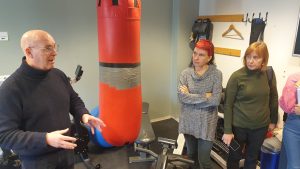
The production school has 5 work departments (kitchen, auto repair, wood work shop, handcrafts and computer room) and an education department. Employers background are carpenters, car mechanic, cook etc., and those workers works as mentors for youngsters. They also have support staff as teachers, psychologist etc. Every employee earns the same wage. Every youngster has individual approach. They emphasise the importance of interactions between youngster’s school counsellor, parents and support staff at production school. Every youngster has their registration of progress, and individual talk on how can support staff help them develop what each individual need. They have an online system called Memaxis, where they create an account of each participant. Staff put information about the youngsters, but also youngster have a huge part of it. They put information in about their wellbeing, goals. They write down the reflection about every 2 – 3 months. Their program is based on mixture of gaining work experiences, to support studying, exercise (physical and mental health) and have fun. They emphasize that children do most of the things, the mentors are there just to show them they care.

Their facilities:
- Kitchen: a cook and youngsters helping him around kitchen and taking care of people who come to dine in. Kitchen is open for guests (50 – 150 per day). They are offering breakfast and lunch on week days, and brunch on Friday.
- Wood work shop: they make urn, label things…
- Auto repair/workshop: they clean cars, and small car repairs.
- Handcrafts: the main project they are working on as a team are projects for bigger companies (labelling boxes, gluing boards ect.). When they don’t have big projects on schedule each individual is working on their own project; the art teacher is there only to support their creativity and make sure they have supplies. They sell their projects on Christmas markets, charity events.
- Green house: to grow plants, vegetables for their kitchen.
- Gym/fitness: youngsters and employees can use the facility at their free time.
- Computer room: they are rebuilding computers, taking out parts of computers that are not functional anymore.
- School: they offer classes of Math and Icelandic.
- BRUARSKOLI (SHORT-TERM SCHOOL FOR CHILDREN WITH BEHAVIOURAL AND EMOTIONAL DIFFICULTIES)
Time of visit: 14:00 – 16:00
hosts Dóra Margrét Sigurðardóttir in Björk Jónsdóttir
It is a short-term school, where children attend their program for about 15 – 18 months. They work as a “bridge” school, where children return back to their origin school after they show improvement. Children who go to their school have ADHD, ODD, autism, attachment disorder, social/behavioural difficulties, substance abuse or criminal offences. Children that attend school are aged from 8 – 15. The employees are psychologists, teachers, social pedagogics, teacher assistants.
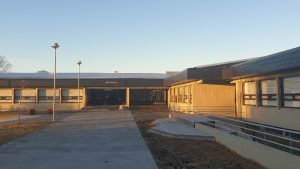
In school, they teach subjects: mathematics, Icelandic, English, reading. All other subjects are covered within various thematic projects. More than school subjects they emphasise education on social skills, communication and behavioural management. One of the programs they are using is Aggressive replacement training (ART).
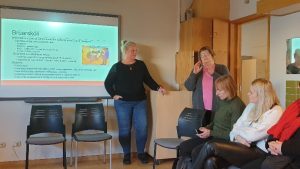
Each child that attend school has individual goals, and individual plan on how to improve their behaviour, and after they accomplish the goals and improve their behaviour, they return back to their origin school. The mobile teachers plan the “step by step” return to the school and offer help and support to the child, family and teachers at their origin school. They usually follow the child for a few more months. Main problem they are facing with when children return to their origin school, is how to change the attitude of teachers.
Questions / discussion:
- Do children feel like they are punished when they are transferred to your school?
Yes, sometimes they do. But after time they feel better and they acknowledge that they are loved and valued here.
- What kind of curriculum are you using, how are children dealing with subject when they go back to their origin school?
We adjust the curriculum we are using. When children return to their school, we give their teacher a report on their knowledge and what was the main focus of each subjects.
- What is your reward system?
Each child has an individual plan, which means they have different goals to achieve (sit calmly at the desk, finish the paperwork in time…), so after they achieve their goal they get a star. When they collect some number of stars, they earn the reward (playing with LEGOs, free time etc.).
- How do you and/or staff deal with emotions at work?
It is important to self-regulate, to talk about what happen on a daily basis, to document everything and to acknowledge what would happen if we wouldn’t do it (ex: step in, in a violent behaviour). It is important to work and support each other in a team. Evaluation with all staff on Friday after work, to talk about the week, about ups and downs, to thank each other, to acknowledge the good.
- What are your work hours? How long children are in school?
Our work week is 36 hours, and children are in school from 8:20 to 13:30 or 13:45.
We also discussed violence. They explained us what steps are they following when violent behaviour occurs among children. The indication for when to use this technic, is when someone might be harmed if it is not used. An educator is never alone in the situation (always at least 3 people, but more often more than that). Each teacher has a school mobile phone to call other staff to assist them with the violent situation. They physically restrain a child that is in danger of themselves or others. In the group of adults calming down the child, every individual knows their role (only one speaks with a child, the others are following and holding a child etc.). They ask the violent child to move into the calming room, and if they don’t go voluntarily, they physically assist them. In the calming room, they give them time out to calm down.
After that we went around in two groups to see school rooms and their documents and other paper work they use for emergencies and on daily basis.
- Calm down room (green room): a room used for child to calm down.
- Classrooms: equipped with moving walls between desks, with chairs on wheels for children with ADHD, timers, headphones for children with noise sensitivity. The classroom for younger children had a darker room for reading or chilling, different board games.
- Work shop room: where children get to craft and make projects.
- Arts room
- Outdoor classroom: mainly for science subjects which are part of thematic days.
- Library
- STIGAMOT (CENTER FOR VICTIMS OF SEXUAL ABUSE)
Visit time: 17:00 – 18:30
host Drífa Snædal
https://stigamot.is/languages/english/
Stigamot is a center for victims of sexual abuse. They are counselling and educational center on sexual abuse and group therapy. They “treat” around 1000 people per year. They have 13 counsellors (12 women and 1 man). They offer free sessions and protections for survivals. People that come to the center, don’t need to give their personal name to be treated. In year 2022, they held 910 cases, from which the highest percentage are victims of rape (70,8 %), and the lowest percentage are victims of prostitution (4,8 %). Out of 910 cases, 91,7 % victims are women, and 7,1 % are men.
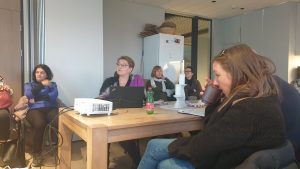
They offer many projects, but we focused on the projects they are offering for young people:
- #sjukt #crazylove: the project is funded by Ministry of Education. It is focused on youngsters from 13 – 20 years old. The counsellors go to school and educate. Beside that they have advertise on school boards, social media, tv…
- Crazy chat: anonymous chat line for teenagers and youngsters. Around 300 teenagers use the platform, most likely girls, over the age of 16.
- In the future they would like to star with a campaign to focus more on boys, how to be the best sex partners etc.
In the debate we were discussing about the importance of sex education in school. In Iceland they have sex education in school, but nowadays it has become more and more debatable whether it is too honest and open, and not appropriate for young people. They showed us international web-side StopNCII.org (Stop Non-Consensual Intimate Image Abuse), where individual who has been a victim of threatening of showing their intimate images can check if the photos is online. We also discussed how are things in Slovenia, and what can be done to be better at educating youngsters to have better relationships.
Day 4
- BARNA-OG FJOLSKYDUSTOFA – NATIONAL AGENCY OF CHILDREN AND FAMILIES
Time of visit: 9:00 – 10:30
host Funi Sigurðsson
https://www.bofs.is/english/about-us/
Main goal of the agency is to work in the interests of child’s prosperity. They have 140 employees, for around 80 children.
The Act of Children Prosperity is one of the “branches” of the Agency. They support all the services for children on the municipally and country level. They support and work together with different profiles (school, kinder garden, health center…)
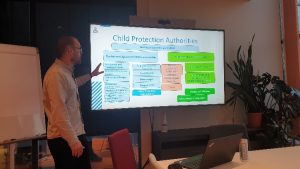
The services they are offering:
- Studlar (3 unites: treatment, emergency and supporting)
- MST program: children are not taken out of the home, but a counsellor is visiting a child in their home, school etc. to support family and everyone involved. Children often have criminal background, difficulties with school, violent behaviour, substance abuse… Each counsellor has 5 families, that he follows for around 3 – 5 months. The questions from the group was, why did they choose MST program – because they had a lot of residential homes, and they wanted to reduce that. And the MST program was very well researched.
- Barnahus (from year 1998). For children who are victims of sexual or severe physical violence, from the age of 3,5 – 18 years old.
- Bjargey (treatment house in nature): long term treatment house for girls and non-binery. Youngsters can stay there for 6 months (or longer), and it has place for 4 – 5 youngsters at the time. It is government run. They go to school out of the institution in the nearest town. The programs they have in a house are art, and family workshops. For the first 3 months they are not allowed to return home to Reykjavik (parents can visit them), after that they have training trips back home to Reykjavik and finally at the end they have unsupervised visits home.
- Laekjarbakki (treatment house in nature): same program as Bjargey, except it is for boys and non-binery. They have school in the building. The average stay is 9 months, and it has place for 6 youngsters.
- Foster care: long term (to 18 years), short term (1 – 2 years), supported (1 – 2 years). In 2020, they had 127 children in foster care.
Questions:
- In what treatment house would you put a girl, that identifies as a boy?
Whatever is in the best interests of a child, wherever he would feel more comfortable.
- Why is long term treatment house only for 6 months? And why is it set in the nature?
It can be longer, but it is not promoted to be longer than that. They realised that after 6 months they are not adding anything positive on child’s development. They don’t want to institutionalized individuals. It is set in the nature, away from Reykjavik because we believe it is crucial to get away from negative environment.
- Do you have any runaways?
Not very often. Around 4 – 5 per year.
- What are your plans for the future?
To have a treatment home in, or closer to Reykjavik.
- STUDLAR, ICELAND’S TREATMENT CENTER FOR TEENAGERS.
Time of visit: 10:30 – 12:30
host Úlfur Einarsson
https://www.bvs.is/urraedi/studlar/
They have three units:
- Treatment unit: youngsters stay here up to 12 weeks. The focus is to improve their strengths, to have more normal life than before. The daily programs/subjects are: education, employment, sports and arts&crafts. They are focusing for the youngsters to go back to their origin school or if that is not possible, they find them work place to gain working experiences. Their prospective on work is to “reframe the behaviour”. Children can’t come to the unit by themselves, but they need to come through Child Protective Services or police. What methods of work they use: Motivational Interview (MI), Aggression replacement therapy (ART), behaviour modification (reward, star system), trauma informed approach.
- Emergency unit / crisis center: children stay here up to 14 days. It is always available, and it is a closed unit. It is focused to stop unacceptable and damaging behaviour. Children come through CPS or Police.
- Supportive home: only for children who have stayed at treatment center on two occasions. They offer individual support and can only be 2 children at the time, until 20 years old.

At the end we went around their facilities. In treatment unit, they have six bedrooms. Each bedroom has one bed and a bathroom. They have group therapy room, art toom, gym, music room. In crisis center they have bedroom, common room, calm down room and outside space (covered on the top, so they can’t escape). Both of that units are under the same roof. Outside there is another entrance to go into supportive home. They have their own kitchen, bathroom and two bedrooms, each with one bed.
Discussion and questions were based a lot on the methods they use. Psychologist explained us what is Motivational Interview (MI), how does it work, how are they implying it into working with children, what are the benefits. They also explained their behaviour modification, the use of stars and steps of improvement. If they are full, they always find a way to help children: either call CPS, rearrange children around units, put them in foster care etc. They pick their employees based on their educational background (psychology or social studies), they need experiences with children, mindset that fits in the work space and have positive interests. Working hours are 8 – 16, 16 – 11, and they have employees that works only in night shifts. If children have medication, the staff keeps them, but they don’t force them to take it, they only encourage them. Children attend school, but only as much as they can; sometimes only 1 hour a week, or once a week. They find to make it work, they find them some online courses. They encourage their interests.
- SKAHM: SERVICES FOR CHILDREN AND YOUTH WITH MULTIFACED PROBLEMS AND THEIR FAMILIES.
Time of visit: 14:00 – 16:00
hosts Elsa Lyng Magnúsdóttir in Halldóra Gyða Matthíasd Proppé
It is a knowledge center that provides a holistic service for children and young people with multifaced problems. The way of working is to meet child’s needs and to strengthening their belief and their abilities so they can grow and prosper on their own terms. Also, to strengthening parenting skills and support, assist parents in their role. The support is flexible, and is held in child’s home and outside the home. It is founded by Reykjavik city. Values that they support are resilience, empowerment, caring and respect.
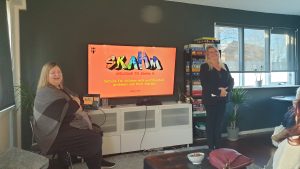
Services they offer:
- Home support and advise: Provides parenting advice to parents and support families based on a support plan. The counsellors have a support phone, and parents (and also counsellors) can call them with problems/questions any time.
- Self-empowerment: It focuses on strengthening children and young people (10 – 16/17 years old) to set realistic and necessary goal. The aim is to promote them in activity and sustainability. They follow up with children and they families even after they reach their goals.
- “Home away from home”: A support for families where a child stays outside their home for 1 – 4 days, depending on circumstances at home. They are open only from Thursday – Monday morning. It offers rest for children’s family and provide sanctuary for children. It reduces stress situations at home.
- Knowledge and advice: It provide parenting advice of enhancing parenting skills and professional guidance to school staff.
In the discussion, they explained us one of their approach: PDA (Pathological Demand Avoidance): it is a helping approach to observe some specific characteristics in children. The mnemonic for working with children who have PDA syptoms, is PANDA (P: Pick battles, A: Anxiety management, N: Negotiation and collaboration, D: Disguise and manage demands, A: Adaptation).
At the end we looked around the rooms of their house that they use as “home away from home”: three single bedrooms, a common area with games, tv, a kitchen and dining room and a bathroom.
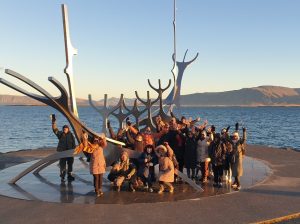
![]()
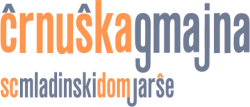

Recent Comments